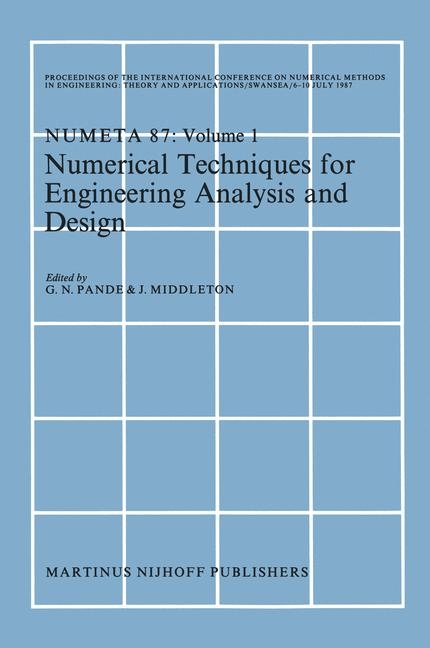
Numerical Techniques for Engineering Analysis and Design
Kluwer Academic Publishers (Verlag)
9789024735648 (ISBN)
- Titel ist leider vergriffen;
keine Neuauflage - Artikel merken
Numerical methods and related computer based algorithms form the logical solution for. many complex problems encountered in science and engineering. Although numerical techniques are now well established, they have continued to expand and diversify, particularly in the fields of engineering analysis and design. Various engineering departments in the University College of Swansea, in particular, Civil, Chemical, Electrical and Computer Science, have groups working in these areas. It is from this mutual interest that the NUMETA conference series was conceived with the main objective of providing a link between engineers developing new numerical techniques and those applying them in practice. Encouraged by the success of NUMETA '85, the second conference, NUMETA '87, was held at Swansea, 6-10 July 1987. Over two hundred and twenty abstracts were submitted for consideration together with a number of invited papers from experts in the field of numerical methods. The final selection of contributed and invited papers were of a high quality and have culminated in the two volumes which form these proceedings. This volume contains papers on the themes of 'Numerical Techniques for Engineering Analysis and Design' and 'Developments in Engineering Software'. Many new developments on a wide variety of topics have been reported and these proceedings contain a wealth of information and references which we believe will be of great interest to theoreticians and practising engineers alike.
Section D - Engineering Analysis and Design.- D1 Coupling of Fluid Film Lubrication and Plastic Deformation: Finite Element Approach of Plastohydrodynamics in Cold Forging.- D2 Rigid and Flexible Mechanisms; A Finite Element Approach based on the Conformal Rotation Vector.- D3 An Analysis of Dynamic Crack Propagation in a Rail web with Longitudinal Residual Stresses.- D4 Finite Element Analysis and Algorithms for Large Elastic.- D5 A Consistent Finite Element Formulation of Nonlinear Frictional Contact Problems.- D6 A Linearization Method for Multilevel Optimization.- D7 Harbor - A Program for Horizontal Load Analysis of Marine Structures.- D8 Shape Identification of a Free Surface with a Uniform Potential and Flux.- D9 A CO Elastoplastic Shell Element Based on Assumed Covariant Strain Interpolations.- D1O Capturing Thermal-Stress Waves via Special Purpose Hybrid Transfinite Elements and Unified Computational Formulations.- D11 The Determination of Optimal Properties of a Layered Pavement Structure.- D12 A Finite Element Method for a Numerical Analysis of the DeepDrawing Process.- D13 Theory of Degenerated Curved Shell and Locking in Shell Finite Elements.- D14 Convergence of Hierarchical Finite Elements.- D15 Numerical Methods for Three Dimensional Analysis of Buildings.- D16 Matrix Mechanics to Classify Non-Linear Continua.- D17 A Mixed Eulerian-Lagrangian Contact Element to Describe Boundary and Interface Behaviour in Forming Processes.- D18 Advances in Aeroelasticity.- D19 Cylindrical Concrete Water Tanks: Analysis and Design.- D20 A Complete Procedure for the Adjustment of a Finite Element Model from the Identified Complex Eigenmodes.- D21 A General Formula of the Curved Shell Elements and Adaptive Mesh Method in the Nonconservative Finite Deformation Analysis.- D22 On Exact and Hierarchical Finite Elements for Frame Structures.- D23 Statically and Kinematically Admissible Finite Element Formulations for Elastic-Plastic Plate Analysis.- D24 Turbulence Modelling and the Effects of Directional Random waves in Computations of Nearshore Circulation.- D25 Analysis of Gravity Dam on Soft Foundation.- D26 A Finite Element Model for Viscoelastic Foundations Supporting Plate Structures.- D27 Computer Aided Simulation of Tooth Contact Analysis for Helical Gears with Involute Shape Teeth.- D28 Stress and Velocity Fields at Discharging of Silos.- D29 The Convergence Properties of a Series of R-Functions for Simple Polygonal Shapes.- D30 Creation of Ship Body Form with Minimum Theoretical Resistance using Finite Element Method.- D31 Transition Plate Bending Elements with Variable Nodes.- D32 A Simple Adaptive Scheme Based on a New Hybrid FE Model.- D33 Two-Dimensional Solidification Analysis for Twin-Roll Continuous Casting.- D34 Variational Formulation by Integral Equations for the Sound Radiation in a Non Uniform Flow.- D35 Design and Study of Behaviour of Brush Bearing Platens by the Finite Element Method.- D36 Water Pollution Control using Finite Element Model.- D37 Three-Dimensional Finite Element Analyses for a Maxwell Fluid using the Penalty Function Method.- D38 Optimization of Continuous Prestressed Beam for Different Construction Stages.- D39 Slope Stability Computations with Nonlinear. Failure Envelope using Generalized Procedure of Slices and Optimization Techniques.- D40 A Computer Code for the Stress Analysis of Cyclically Symmetric Components.- D41 A Numerical Method for the Determination of the MomentRotation- Capacity of Thin Walled Members.- D42 Some Applications of Load-Deformation States.- D43 A Second Generation Structural Shape Optimization Capability Employing a Boundary Element Formulation.- D44 An Experimental and Theoretical Study of Soil-Structure Interaction in the Case of a Shallow Foundation Model.- D45 Dynamic Analysis of General Thin Shells.- D46 A Simplified Analysis of Two Plate Bending Elements - The MITC4 and MITC9 Elements.- D47 High-Speed Loading Analysis of Reinforced Concrete Columns.- D48 Analysis of Footing Behaviour on Homogeneous and Layered Soils.- D49 Fracture Mechanics for Delamination on Composite Structures in Compression.- D50 A New Multivariable Finite Element Algorithm and a Breakable Element Algorithm for Elasto-Plastic Fracture Analysis.- D51 Preliminary Seismic Analysis and Design of Liquid Storage Tanks.- D52 Optimal Design of Semiconductor Components.- D53 Reflections on Finite Element Plate Analysis.- D54 Finite Element Model for Layered Plates/Shells.- D55 An Approach to Correct Elasto-viscoplastic Stress Predictions.- D56 Finite Element Analysis of a Viscoelastic Solid Sliding over Rigid Triangular Asperities.- D57 Non-Linear Analysis of Arch Dams.- D58 2-D Moving Grid FEM for Diffusion Problems with Chemical Reactions.- Section S - Developments in Engineering Software.- Sl Are High Degree Elements Preferable? Some Aspects of the h and h-p Version of the Finite Element Method.- S2 Handicraft in Finite Elements.- S3 Adaptive Techniques in Finite Element Analysis.- S4 Aspects of Methodology for FE-Program Development.- S5 The Significance and Practice of Rank Estimation in Structural Dynamics Identification Algorithms.- S6 The Use of Tension Parameter in Surface Modelling.- S7 Direct Design Versus Range Selection Algorithms used in Mechanical Component Software.- S8 Analog/Hybrid and Digital Simulations in Civil Engineering.- S9 Curve Design using Hierarchical Finite Element Forms.- S1O Integration of FEM, Optimization, and CAD on Microcomputers.- S11 An Adaptive HP-Version in the Finite Element Method.- S12 A Finite Element Transitional Mesh Generation Technique.- S13 Expert System for Material Selection.- S14 A Dynamically Partitioned Out-of-Core Skyline Solver for MicroComputers.- S15 A Generalised A-Posteriori Analysis of the Discretization Error in Numerical Solutions to Linear Problems.- S16 Analysis of Cantilever Sheet Piling in Stratified Cohesive Soils.- S17 A Geometrical Continuous Remeshing Procedure for Application to Finite Element Calculation of Non-Steady State Forming Processes.- S18 Improved Systolic Designs for the Iterative Solution of Linear Systems.- S19 Superconvergence and Finite Element Post Processing.- S20 Automatic Generation of Shape Function Routines.- S21 The Generation of Hybrid Structured- Unstructured Grids.
| Zusatzinfo | 746 p. |
|---|---|
| Verlagsort | Dordrecht |
| Sprache | englisch |
| Gewicht | 1070 g |
| Themenwelt | Mathematik / Informatik ► Mathematik ► Analysis |
| Mathematik / Informatik ► Mathematik ► Wahrscheinlichkeit / Kombinatorik | |
| ISBN-13 | 9789024735648 / 9789024735648 |
| Zustand | Neuware |
| Informationen gemäß Produktsicherheitsverordnung (GPSR) | |
| Haben Sie eine Frage zum Produkt? |
aus dem Bereich


